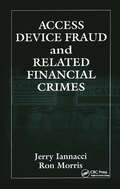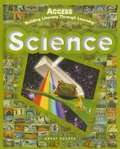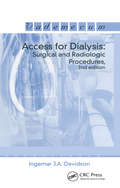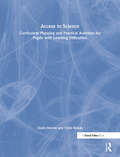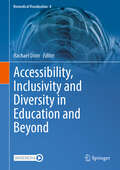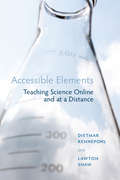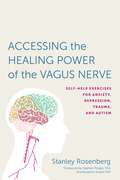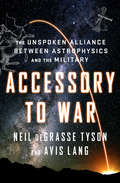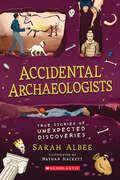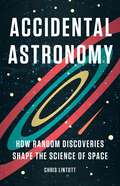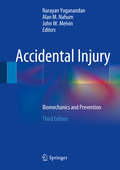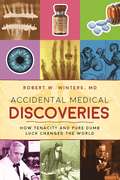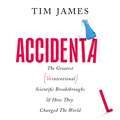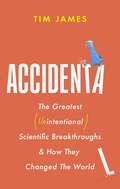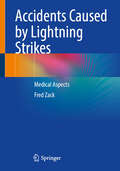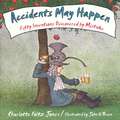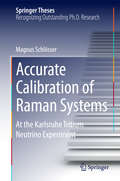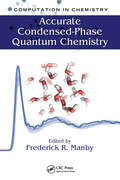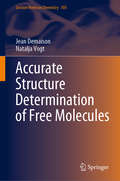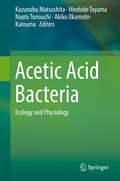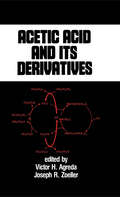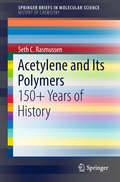- Table View
- List View
Access Device Fraud and Related Financial Crimes
by Jerry IannacciAccess Device Fraud and Related Financial Crimes offers front-line exposure. It is a reference text that affords the student, financial investigator or law enforcement professional a true insight into a wide spectrum of criminal activity involving financial crimes. This book brings the reader back to the scene of cases in which the intensity and ma
Access for Dialysis: Surgical and Radiologic Procedures, Second Edition
by Ingemar J.A. DavidsonThis publication is intended as a guide to common diagnostic, operative and percutaneous techniques used in creating and maintaining vascular access for hemodialysis. When writing the text, the authors have focused on surgeons in training, fellows, interventional radiologists and clinically active nephrologists. Dialysis nurses and other clinicians
Access to Science: Curriculum Planning and Practical Activities for Pupils with Learning Difficulties
by Claire Marvin Chris StokoeThis accessible and practical teaching resource focuses on access to the science curriculum for pupils with learning difficulties. Within an inclusive framework of participation and achievement for all, the core of the book provides support and ideas for the effective planning and implementation of well-differentiated science-focused activities. The book offers activities that are designed to motivate and challenge pupils with diverse individual needs; guidance on differentiation in early years and across all key stages; suggestions for teaching early developmental skills through sensory science; defined learning outcomes that demonstrate progression in curriculum content and experience; assessment and recording opportunities; and guidance on how to incorporate science in a cross-curricular way. Written by authors who have direct experience in the field, this book will provide practical help to all those working with pupils with learning difficulties in early years settings and in mainstream and special schools.
Accessibility, Inclusivity and Diversity in Education and Beyond (Biomedical Visualization #8)
by Rachael DoorThis book provides a unique opportunity to explore the current and future state of accessibility, inclusivity, and diversity across higher education and beyond. Although these chapters primarily focus on the issues and resulting adaptations seen in biomedicine, the results and observations are applicable throughout education and the workplace. Section 1 focuses on what it means to create accessible environments for both education and employment. Here the pitfalls of mandatory attendance across education will be addressed and ideas for building belonging amongst students shared. In addition, ways to use play-based learning to support student revision and to make psychology accessible to medical students will be discussed. Section 2 explores inclusive practices in anatomy education and research, with a toolkit for both early-career and established academics. The pedagogy, psychology, and culture of asking and answering questions in education will also be explored to support educators aiming to create inclusive learning environments. Section 3 focuses on ways in which diversity can be embraced in the educational, medical, and public sectors. Chapters include the use of human remains as teaching aids to promote the concept of the body as a spectrum, and the use of television media to create immersive learning environments. This book is an essential guide to creating accessible, inclusive, and diverse learning environments for both the early career and experienced academic.
Accessing the Healing Power of the Vagus Nerve: Self-Help Exercises for Anxiety, Depression, Trauma, and Autism
by Benjamin Shield Stephen W. Porges Stanley RosenberyThis practical guide to understanding the cranial nerves as the key to our psychological and physical well-being builds on Stephen Porges’s Polyvagal Theory—one of the most important recent developments in human neurobiology. Drawing on more than thirty years of experience as a craniosacral therapist and Rolfer, Stanley Rosenberg explores the crucial role that the vagus nerve plays in determining our psychological and emotional states and explains that a myriad of common psychological and physical symptoms—from anxiety and depression to migraines and back pain—indicates a lack of proper functioning in the vagus nerve. Through a series of easy self-help exercises, the book illustrates the simple ways we can regulate the vagus nerve in order to initiate deep relaxation, improve sleep, and recover from injury and trauma. Additionally, by exploring the link between a well-regulated vagus nerve and social functioning, Rosenberg’s findings and methods offer new hope that by improving social behavior it is possible to alleviate some of the symptoms at the core of many cases of autism spectrum disorders. Useful for psychotherapists, doctors, bodyworkers, and caregivers, as well as anyone who experiences the symptoms of chronic stress and depression, this book shows how we can optimize autonomic functioning in ourselves and others, and bring the body into the state of safety that activates its innate capacity to heal.
Accessory to War: The Unspoken Alliance Between Astrophysics And The Military
by Avis Lang Neil DeGrasse TysonAn exploration of the age-old complicity between skywatchers and warfighters, from the best-selling author of Astrophysics for People in a Hurry. <P><P>In this fascinating foray into the centuries-old relationship between science and military power, acclaimed astrophysicist Neil deGrasse Tyson and writer-researcher Avis Lang examine how the methods and tools of astrophysics have been enlisted in the service of war. "The overlap is strong, and the knowledge flows in both directions," say the authors, because astrophysicists and military planners care about many of the same things: multi-spectral detection, ranging, tracking, imaging, high ground, nuclear fusion, and access to space. Tyson and Lang call it a "curiously complicit" alliance. "The universe is both the ultimate frontier and the highest of high grounds," they write. "Shared by both space scientists and space warriors, it’s a laboratory for one and a battlefield for the other. The explorer wants to understand it; the soldier wants to dominate it. But without the right technology—which is more or less the same technology for both parties—nobody can get to it, operate in it, scrutinize it, dominate it, or use it to their advantage and someone else’s disadvantage." <P><P>Spanning early celestial navigation to satellite-enabled warfare, Accessory to War is a richly researched and provocative examination of the intersection of science, technology, industry, and power that will introduce Tyson’s millions of fans to yet another dimension of how the universe has shaped our lives and our world. <P><b>A New York Times Bestseller</b>
Accidental Archaeologists: True Stories of Unexpected Discoveries
by Sarah AlbeeScience meets real-life mystery in this adventurous look at incredible unexpected finds that changed history.Secret treasures are buried all around us -- you just have to look for them!Accidental Archaeologists takes you on an adventure through time to relive some of the coolest surprise discoveries by totally ordinary people all over the world. Meet:- The cowboy who found an ancient skeleton- A famous king buried underneath a parking lot- The team who found New York City's hidden African Burial Ground- A boy who finds the Dead Sea Scrolls while looking for his lost goat- And many more.Packed with incredible stories and expert tips for making your own exciting finds, this is an accessible, action-packed introduction to the world of archaeology.
Accidental Astronomy: How Random Discoveries Shape the Science of Space
by Chris LintottA "riveting real-life Hitchhiker's Guide to the Galaxy" (The Telegraph) and "whirlwind tour of wondrous celestial phenomena" (The Idler) shows why so much of astronomy comes down to looking up and lucking out If you learn about the scientific method, you learn that first we hypothesize about something we&’ve experienced, and then we look for more of it. This works well enough—but what if you are interested in studying a heretofore unknown comet or supernova? That is the essential problem of the astronomer: the most important discoveries happen without notice! Indeed, as Chris Lintott argues in Accidental Astronomy, luck defines astronomy. Lintott explores the ways in which happenstance shapes how we investigate the sky. To catch a glimpse of a comet, asteroid, or even a sign of alien life, we must be in the right place at the right time. And if we can&’t be there, we must have a team of professionals and amateurs, across the globe, ready to spring into action at a moment&’s—or a night&’s—notice. For any astronomer, regardless of their experience or resources, the first step to discovery is the same: to stare at the sky and wait. A celebration of astronomy, stargazing, and cosmic discovery, Accidental Astronomy offers an irresistible window into how luck defines our knowledge of the skies.
Accidental Injury: Biomechanics and Prevention
by Narayan Yoganandan Alan M. Nahum John W. MelvinThis book provides a state-of-the-art look at the applied biomechanics of accidental injury and prevention. The editors, Drs. Narayan Yoganandan, Alan M. Nahum and John W. Melvin are recognized international leaders and researchers in injury biomechanics, prevention and trauma medicine. They have assembled renowned researchers as authors for 29 chapters to cover individual aspects of human injury assessment and prevention. This third edition is thoroughly revised and expanded with new chapters in different fields. Topics covered address automotive, aviation, military and other environments. Field data collection; injury coding/scaling; injury epidemiology; mechanisms of injury; human tolerance to injury; simulations using experimental, complex computational models (finite element modeling) and statistical processes; anthropomorphic test device design, development and validation for crashworthiness applications in topics cited above; and current regulations are covered. Risk functions and injury criteria for various body regions are included. Adult and pediatric populations are addressed. The exhaustive list of references in many areas along with the latest developments is valuable to all those involved or intend to pursue this important topic on human injury biomechanics and prevention. The expanded edition will interest a variety of scholars and professionals including physicians, biomedical researchers in many disciplines, basic scientists, attorneys and jurists involved in accidental injury cases and governmental bodies. It is hoped that this book will foster multidisciplinary collaborations by medical and engineering researchers and academicians and practicing physicians for injury assessment and prevention and stimulate more applied research, education and training in the field of accidental-injury causation and prevention.
Accidental Inventions (Fountas & Pinnell LLI Gold #Level R)
by Alison BlankAccidental Inventions Author: Alison Blank
Accidental Medical Discoveries: How Tenacity and Pure Dumb Luck Changed the World
by Robert W. WintersMany of the world's most important and life-saving devices and techniques were often discovered purely by accident. Serendipity, timing, and luck played a part in the discovery of unintentional cures and breakthroughs:A plastic shard in an RAF pilot's eye leads to the use of plastic for contact lenses.The inability to remove a titanium chamber from rabbit's bone leads to dental implants.Viagra was discovered by a group of chemists, working in the lab to find a new drug to alleviate the pain of angina pectoris.A stretch of five weeks of unusually warm weather in 1928 played a role in assisting Dr. Alexander Fleming in his analysis of bacterial growth and the discovery of penicillin.After studying the effects of the venom injected by the bite of a deadly pit viper snake, chemists developed a groundbreaking drug that works to control blood pressure.Accidental Medical Discoveries is an entertaining and enlightening look at the creation of 25 medical inventions that have changed the world - unintentionally. The book is presented in a lively and engaging way, and will appeal to a wide variety of readers, from history buffs to trivia fanatics to those in the medical profession.
Accidental: The Greatest (Unintentional) Science Breakthroughs and How They Changed The World
by Tim James'Who said science was dry? Certainly not Tim James' New York Post 'James writes with infectious enthusiasm and optimism' Kirkus Reviews 'A science teacher by profession, Mr. James knows how to get his audience's attention' Wall Street Journal 'Humorous, yet deep' Professor Charles AntoineA rip-roaring adventure through science gone wrong, and accidentally changing humanity (mostly) for the better.We may imagine that science is a process of breakthroughs and light bulb moments. But in reality, science goes wrong 99% of the time.Almost every idea a scientist comes up with is quickly disproved by a failed experiment or rival research. Science moves at a rate of inches per decade and we often like it that way. But occasionally, just occasionally, a complete fluke happens and changes everything as we know it. From an untimely sneeze in a petri dish leading to the groundbreaking creation of antibiotics, to the incredible discovery of microwaves via melted chocolate, Accidental is a rip-roaring adventure through science gone wrong, and accidentally changing humanity for the better.
Accidental: The Greatest (Unintentional) Science Breakthroughs and How They Changed The World
by Tim James'Who said science was dry? Certainly not Tim James' New York Post 'James writes with infectious enthusiasm and optimism' Kirkus Reviews 'A science teacher by profession, Mr. James knows how to get his audience's attention' Wall Street Journal 'Humorous, yet deep' Professor Charles AntoineA rip-roaring adventure through science gone wrong, and accidentally changing humanity (mostly) for the better.We may imagine that science is a process of breakthroughs and light bulb moments. But in reality, science goes wrong 99% of the time.Almost every idea a scientist comes up with is quickly disproved by a failed experiment or rival research. Science moves at a rate of inches per decade and we often like it that way. But occasionally, just occasionally, a complete fluke happens and changes everything as we know it. From an untimely sneeze in a petri dish leading to the groundbreaking creation of antibiotics, to the incredible discovery of microwaves via melted chocolate, Accidental is a rip-roaring adventure through science gone wrong, and accidentally changing humanity for the better.
Accidental: The Greatest (Unintentional) Science Breakthroughs and How They Changed The World
by Tim James'Who said science was dry? Certainly not Tim James' New York Post 'James writes with infectious enthusiasm and optimism' Kirkus Reviews 'A science teacher by profession, Mr. James knows how to get his audience's attention' Wall Street Journal 'Humorous, yet deep' Professor Charles AntoineA rip-roaring adventure through science gone wrong, and accidentally changing humanity (mostly) for the better.We may imagine that science is a process of breakthroughs and light bulb moments. But in reality, science goes wrong 99% of the time.Almost every idea a scientist comes up with is quickly disproved by a failed experiment or rival research. Science moves at a rate of inches per decade and we often like it that way. But occasionally, just occasionally, a complete fluke happens and changes everything as we know it. From an untimely sneeze in a petri dish leading to the groundbreaking creation of antibiotics, to the incredible discovery of microwaves via melted chocolate, Accidental is a rip-roaring adventure through science gone wrong, and accidentally changing humanity for the better.
Accidents Caused by Lightning Strikes: Medical Aspects
by Fred ZackThe book presents relevant medical aspects of accidents caused by lightning strikes in a practical manner and is supported by case examples: from the fundamentals of energy transfer to emergency medical first aid, the treatment of sequelae, and the medical examination of the deceased. It is aimed at physicians of all specialties who are involved in the acute care or follow-up of individuals after lightning strike accidents, such as those from emergency medicine, legal medicine, intensive care, and general medicine.
Accidents May Happen
by Charlotte JonesFrom Wheaties to telephones, microwave ovens to yo-yos, here are the inspiring and often funny stories of 50 mistakes and misunderstandings that helped bring about life as we know it. With hilarious cartoons and wacky facts, this fascinating compendium illustrates the adage "If you don't learn from your mistakes, there's no sense making them."From the Trade Paperback edition.
Accretion Processes In Astrophysics
by Ignacio González MartÍnez-PaÍs Tariq Shahbaz Jorge Casares VelázquezIt has been more than fifty years since the first significant paper on accretion flows was written. In recent years, X-ray satellites capable of identifying accretion disks and radiation jets – indications that accretion has taken place – have significantly advanced our understanding of these phenomena. This volume presents a comprehensive and up-to-date introduction to the major theoretical and observational topics associated with accretion processes in astrophysics. Comprising lectures presented at the twenty-first Winter School of the Canary Islands Institute of Astrophysics, the text emphasises the physical aspects of accretion, investigating how radiation jets are produced, how accretion power is divided between jets and radiated energy, the geometry of accretion flow, and the accretion processes of active galactic nuclei. Written by an international team of experienced scientists, chapters offer young researchers key analytical tools for supporting and carrying out the next generation of front-line research.
Accurate Calibration of Raman Systems: At the Karlsruhe Tritium Neutrino Experiment (Springer Theses)
by Magnus SchlösserNeutrinos can arguably be labeled as the most fascinating elementary particles known as their small but non-zero rest mass points to new mass generating mechanisms beyond the Standard Model, and also assigns primordial neutrinos from the Big Bang a distinct role in shaping the evolution of large-scale structures in the universe. The open question of the absolute neutrino mass scale will be addressed by the Karlsruhe Tritium Neutrino (KATRIN) experiment, currently under construction. This thesis reports major contributions to developing and implementing new laser-spectroscopic precision tools to continuously monitor the isotope content of the windowless gaseous tritium source of KATRIN. The method of choice, Raman spectroscopy, is ideally suited for in-situ monitoring of all six hydrogen isotopologues. In a series of beautiful experiments the author obtained two independent novel calibration methods, first based on a comparison of experimental Raman depolarization ratios with corresponding quantum-chemical calculations, and second on a gas sampling technique. Both methods yield consistent cross-calibration results and, as well as yielding improvements in precision, will be of major importance in reducing systematic effects in long-term neutrino mass measurements. The methods developed in this thesis also have great potential to further broaden the applications of Raman spectroscopy to study extended sources such as in atmospheric physics.
Accurate Condensed-Phase Quantum Chemistry (Computation in Chemistry)
by Frederick R. ManbyThe theoretical methods of quantum chemistry have matured to the point that accurate predictions can be made and experiments can be understood for a wide range of important gas-phase phenomena. A large part of this success can be attributed to the maturation of hierarchies of approximation, which allow one to approach very high accuracy, provided t
Accurate Structure Determination of Free Molecules (Lecture Notes in Chemistry #105)
by Natalja Vogt Jean DemaisonThis book presents a detailed look at experimental and computational techniques for accurate structure determination of free molecules. The most fundamental property of a molecule is its structure – it is a prerequisite for determining and understanding most other important properties of molecules. The determination of accurate structures is hampered by a myriad of factors, subjecting the collected data to non-negligible systematic errors. This book explains the origin of these errors and how to mitigate and even avoid them altogether. It features a detailed comparison of the different experimental and computation methods, explaining their interplay and the advantages of their combined use. Armed with this information, the reader will be able to choose the appropriate methods to determine – to a great degree of accuracy – the relevant molecular structure.
Acetic Acid Bacteria: Ecology and Physiology
by Kazunobu Matsushita Hirohide Toyama Naoto Tonouchi Akiko Okamoto-KainumaThis book provides all facets of acetic acid bacteria (AAB) and offers the future targets and directions of AAB research. It summarizes the distinctive physiological properties of AAB and the recent progress on AAB study, especially in the following five areas: 1) Molecular phylogeny and genome study of AAB; 2) Ecological features of AAB: interaction with plants, natural fermentation systems, and insects; 3) Physiological features and living strategies of AAB, including rapid oxidation ability, acid resistance, biofilm formation, and genetic instability; 4) Molecular mechanisms of several oxidative fermentations such as acetate fermentation, sorbose fermentation, and ketogluconate fermentation; 5) Recent biotechnological aspects of AAB: biocatalysts, biosensors, biocellulose, and other useful polysaccharides. AAB research has a long history since the discovery of AAB by Louis Pasteur and the identification of AAB by Martinus Beijerinck in the nineteenth century. In the twentieth century, basic research on the taxonomic study of AAB and on biochemical study for the unique oxidative reactions of AAB had progressed as well as the industrial application of AAB not only in vinegar fermentation but also in the bioconversion process for useful chemical or pharmaceutical products. Entering the twenty-first century, AAB research has expanded more, and further progress is expected to be seen in all fields of AAB: classification and ecology, physiology and biochemistry, genetics, and biotechnology of vinegar fermentation and other oxidative fermentations. Far-reaching development in the last decade makes these bacteria more valuable for various industrial uses. Readers can obtain useful and comprehensive information which is exciting in aspects of basic science and provides hints for the better application of these bacteria to various kinds of practical production scenarios as well.
Acetic Acid and its Derivatives
by Victor H. Agreda Joseph R. ZoellerStriking a balance between basic chemistry and chemical engineering, this up-to-date reference discusses important aspects of acetic acid and its major derivatives, including chemistry, methods of preparation and manufacture, and synthesis, as well as current and emerging downstream technologies.;The book provides comprehensive physical property da
Acetylene and Its Polymers: 150+ Years of History (SpringerBriefs in Molecular Science)
by Seth C. RasmussenThis Brief presents for the first time a detailed historical overview of the development of acetylene polymers, beginning with the initial discovery of acetylene in 1836 and continuing up through the 2000 Nobel Prize in Chemistry. The polymerization of acetylene is most commonly associated with polyacetylene, which was found to be conductive when treated with oxidizing agents such as Br2 or I2 in the mid‐to‐late 1970s. In fact, under the right conditions, oxidized polyacetylenes can exhibit conductivities into the metallic regime, thus providing the first example of an organic polymer exhibiting metallic conductivity. As a consequence, the 2000 Nobel Prize in Chemistry was awarded to Hideki Shirakawa, Alan MacDiarmid, and Alan Heeger for this pioneering research, the award citation reading “for the discovery and development of electrically conductive polymers.” Because of this, most incorrectly view polyacetylene, as well as conducting polymers in general, to originate in the 1970s. In this work, the author examines the polymerization of acetylene from early thermal polymerization studies to the ultimate production of the fully conjugated polyacetylene. Although true polyacetylene was not successfully produced until the 1950s by Giulio Natta, the polymerization of acetylene dates back to 1866 with the work of Marcellin Berthelot. These initial efforts were continued by a range of scientists to produce a polymeric material collectively given the name cuprene in 1900 by Paul Sabatier. Between the initial cuprene studies and the production of true polyacetylene, two related materials were also studied, usually referred to as polyenes and polyvinylenes. Although both of these materials could be thought of as forms of polyacetylene, neither was actually generated from the direct polymerization of acetylene. Readers will gain insight into the fact that polyacetylene and conducting organic polymers have a much longer history than commonly believed and involved the work of a significant number of Nobel Laureates.
